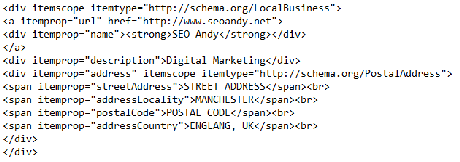It’s been a few years since I began harking on about how Microformats and Structured Data would change search results and enable the world we live in to evolve – I even mentioned it in 2008 in one of my frist posts for SEOAndy (the perfect seo page). Since then I’ve remained an advocated of using them and attracting other websites to use them – thankfully since 2008 things have become a little easier with implementation.
This article is about why you should be implementing microformats and the advantages you can gain over your competitors in doing so. I will also be equipping you with some tools to make strucutres data really work for you.
What is Structured Data?
Before we begin I want to quickly explain what Structured Data is and how it fits into todays modern world of search.

Implemented correctly Structured Data can show in search engines like the example to the right – items in purple squares are directly from Structured Data within those pages.
But Structured Data is about more than allowing search engiens to know what a piece of content is about, its about allowing a search engine to use that data to join other disparate data points. Together this means Google “knows” about a subject and can be semantically searched, this allows for clever apps like Google Now to take full advantage.
For example if you ask Google Now, “Who is the president of america?” you will get the answer- you can then ask “who is his wife?” and then “how tall is she?” – note that you are now giving her name or his name but rather Google knows these are related items and can give you the answer you want straight away, as well as link you to a relevant article.
What Can Be Marked Up Using MicroFormats?
Each time I speak about Structured Data and Microformats, anywhere, I am asked the same questions … the main one is “what can i use it for?” … the answer is almost everything can be marked up – but only certain markup’s will show in search results pages on a regular basis (this isn’t to say they aren’t used in Google Now etc).
So here are some of the commonly visible microformats from Search.
- Authorship - Google Specific currently, also recently dropped profile images
- Video – objects like length of video and author can be assigned
- Music – Time, Album, Name, Artist etc
- Recipes – rating, calories, incredients, time to cook etc
- Products – price, size, colours, sex etc
- Ratings – stars, author name, number of ratings, avg rating
- Business Info – Address, reviews, opening hours, services etc
- Events – Name, Time, Location, Price etc
There are many more fragments of a search results page, you can see the majority of them in this MEGA SERP visual guide from moz.
Will Implementing MicroFormats Boost My Rankings?
This is a very hard question to answer. Ultimately, today, I would say that whilst not directly boosting your rankings, MicroFormats / Structured Data can really help your exisitng rankings.
To be clear, MicroFormats will not appear on every search result shown for a page with that mark-up, usually its the first page or two of results (if you are lucky). This means that if you have really good quality content, and you are ranking well or known in your industry you will do well and data will show. In my experience, this data will make you stand out from the crowd as an expert and it will increase the number of clicks you recieve to that page.
How Do I Implement MicroFormats?
There are a number of potential options for implementing Structured Data with MicroFormats hCard’s and vCard’s – I’ve also spoke about DublinCore – but honestly my vote goes to Schema.Org.
Schema claims to provide a collection of schemas that webmasters can use to markup HTML pages in ways recognized by major search providers, and that can also be used for structured data interoperability …
Err, yeh for the everday webmaster and business owner… This means that Schema offers a instruction on how to tag your content and code, to ensure search engines can make it easier to find your content, link it together and display it in innovative ways.

When you take a look at a scheme, for example a local animal shelter or even a software application, don’t worry about having to have every attribute they list. You can use just a few key tags / attributes in your markup and that will do just fine – obivously if you have more great, if not oh well – there is only so much you can list in a search result

Before you, your SEO team or your web developers implement MicroFormats it maybe an idea to look at the Rich Snippets guidelines from Google which include best practice for structured data.
Are There Any Tools To Help Me?

The two main tools I suggest are operated by Google itself.
First up is Google Strucutred Data Testing Tool, simply put in your url and hit test. It will display how your data looks ina serach results and lists out the other data it can see for that page, site and how they are connected. You can also dump in your html to check if that works (so no need to have a live website for this tool). - TIP: you can also put in your competitors url’s and check for microformats (if any!) they use on their web pages, for example here is a test for an SEO Andy Blog.
Secondly, look to your Google Webmaster Tools (under search appearance is structured data) – there is a similar function in Bing Webmaster Tools too – this will monitor for errors and let you know where they are on your site. This is great if you have changed a theme or function, it also means you can pin point if its an area specific issue or your whole website – and so tell how urgent it is to fix.
Other Tools?
There are also a few other tools worth a mention:
- Schema Creator – a tool for implementing Structured Data, simply put in your data and copy it to the right location… this is OK for one-off works but in the long-term wouldn’t work.
- Platform Plugins – there are lots of plugins for platforms like wordpress and magento which will implement some level of MicroFormat… anything is better than nothing – simply search on google.
- Data Linter – this is a great tool and a more detailed version of what Googles Tester does, though probably less useful as it’s not Google.
Tips For Implemeting Structured Data
Ok, so there is lots of information above but you just want the key takeaways, right? Well here goes…
- MicroFormats IS in use today and should be implemented on most websites.
- MicroFormats won’t boost rankings but can help your rankings.
- Schema.org is currently the best way to implement microformats.
- You may need a seo expert or web developer to help implement microformats.
- You should ALWAYS test your implementation before going live.
- Always monitor your Structured Data for errors and additions you can make.
- Watch SEO News blogs for updates on how Google updates serps.
Original SEO Content by SEO Andy @ Structured Data – Your Key to Search Success in 2014

